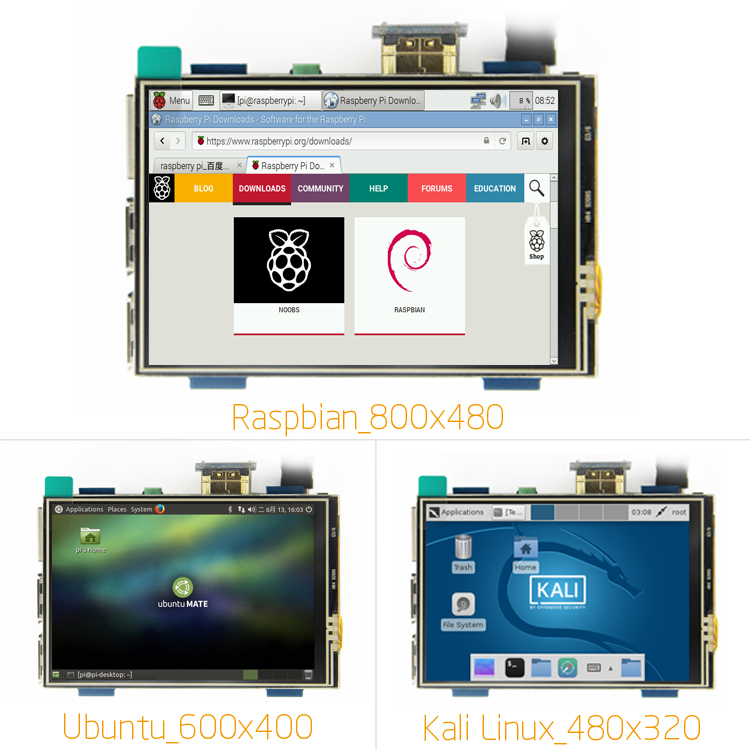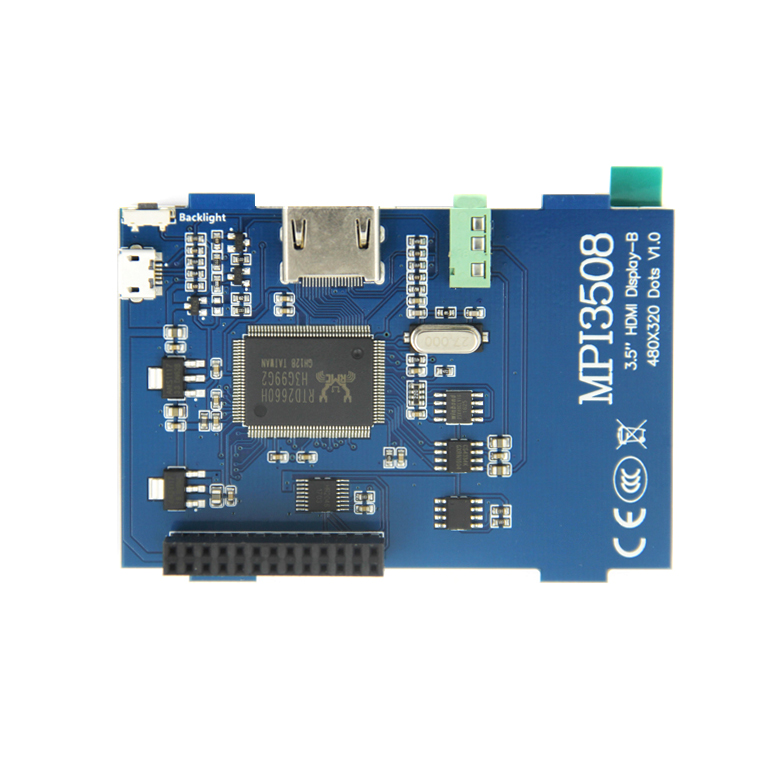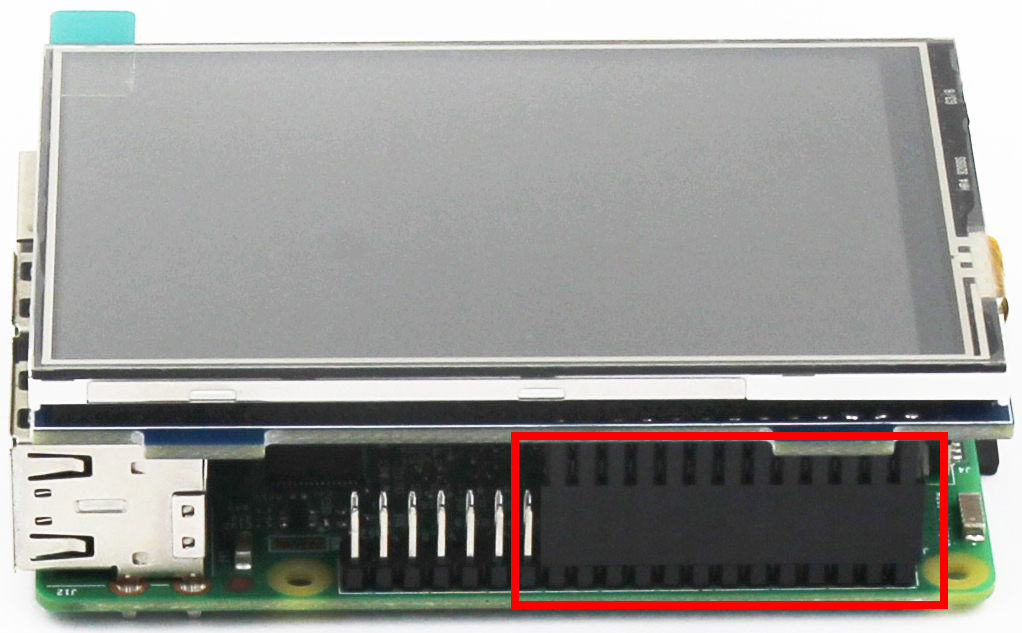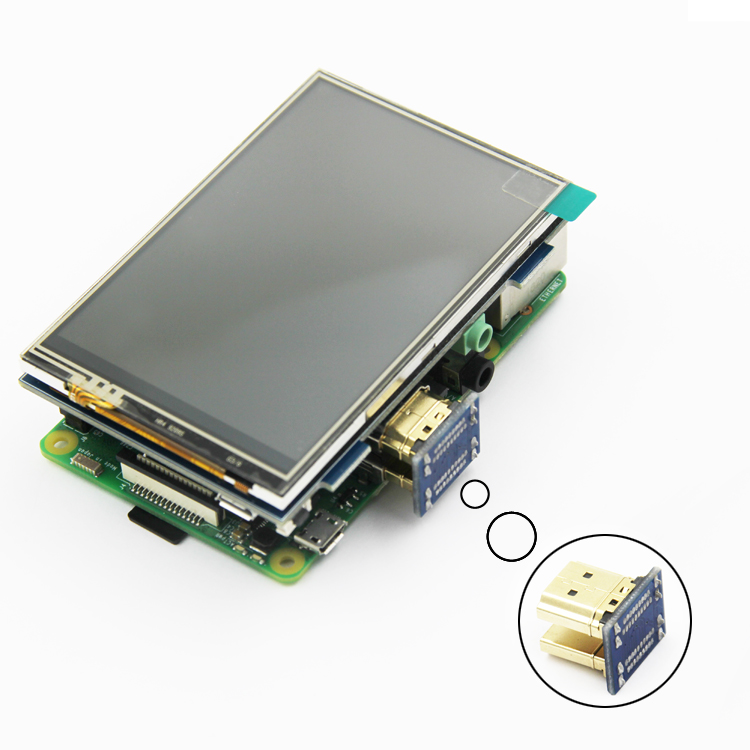更多语言
更多操作
无编辑摘要 |
无编辑摘要 |
||
| (未显示3个用户的110个中间版本) | |||
| 第1行: | 第1行: | ||
[[en:3.5inch_HDMI_Display-B]] | |||
{{#widget:StyledHeader | |||
| color = blue | |||
| | |||
}} | }} | ||
= <font color="blue">产品视频</font> = | |||
{{#ev:youku|XMzk0ODY4MjcyOA}} | {{#ev:youku|XMzk0ODY4MjcyOA}} | ||
*[http://www.lcdwiki.com/zh/演示视频 相关视频] | *[http://www.lcdwiki.com/zh/演示视频 相关视频] | ||
= <font color="blue">产品图片</font> = | |||
{{gallery|width=300px|height=300px | |||
|File:MPI3508-03.jpg|MPI3508-TopView | |||
|File:MPI3508-02.jpg|MPI3508-ButtomView | |||
}} | |||
= <font color="blue">产品介绍</font> = | |||
* 3.5inch标准显示器,支持HDMI输入,刷新率60FPS以上 | * 3.5inch标准显示器,支持HDMI输入,刷新率60FPS以上 | ||
* 物理分辨率480x320,可配置软件分辨率高达1920x1080 | * 物理分辨率480x320,可配置软件分辨率高达1920x1080 | ||
| 第25行: | 第23行: | ||
* 支持HDMI音频输出,背光亮度可调节 | * 支持HDMI音频输出,背光亮度可调节 | ||
= <font color="blue">产品参数</font> = | |||
* 尺寸: 3.5(inch) | |||
* 尺寸:3.5(inch) | |||
* SKU: MPI3508 | * SKU: MPI3508 | ||
* 物理分辨率:480×320(dots) | * 物理分辨率: 480×320(dots) | ||
* 软件可调分辨率:480×320~1920×1080(dots) | * 软件可调分辨率: 480×320~1920×1080(dots) | ||
* 触摸:电阻触摸屏 | * 触摸: 电阻触摸屏 | ||
* USB输入电源:5V 1A | * USB输入电源: 5V 1A | ||
* 功耗:0.18A*5V | * 功耗: 0.18A*5V | ||
::510mW (背光关闭) | |||
* 外形尺寸: 85.5*60.6(mm) | * 外形尺寸: 85.5*60.6 (mm) | ||
* 包装尺寸: 143*134*51 (mm) | * 包装尺寸: 143*134*51 (mm) | ||
* 重量: | * 重量(含包装): 142(g) | ||
= <font color="blue">硬件说明</font> = | |||
=== 硬件介绍 === | |||
[[File:MPI3508-20181115.jpg|493x493像素]] | |||
[[File:MPI3508-20181115.jpg| | |||
<br /><big>①</big>背光按键:背光亮度调节按键,短按背光变化10%,长按3秒关闭背光 | <br /><big>①</big>背光按键:背光亮度调节按键,短按背光变化10%,长按3秒关闭背光 | ||
| 第56行: | 第52行: | ||
*接口定义 | *接口定义 | ||
[[文件:MPI3508-PIN.jpg|无框| | [[文件:MPI3508-PIN.jpg|无框|546x546像素]] | ||
*产品尺寸图 | *产品尺寸图 | ||
[[文件:MPI3508-07.PNG|无框| | [[文件:MPI3508-07.PNG|无框|965x965像素]] | ||
= 使用说明 = | |||
== | === <font color="blue">在树莓派Raspbian/Ubuntu Mate/Kali或Retropie系统中使用</font> === | ||
<big>'''方法一:快速安装(树莓派需连接互联网)'''</big> | <big>'''方法一:快速安装(树莓派需连接互联网)'''</big> | ||
| 第71行: | 第68行: | ||
# 按官方教程步骤安装好系统 | # 按官方教程步骤安装好系统 | ||
* '''步骤2,安装LCD驱动 '''<br /> | * '''步骤2,将SD卡插入树莓派,按照图片所示连接硬件:''' | ||
{{gallery|width=300px|height=300px | |||
|File:MPI3508-001.jpg|将显示屏对齐树莓派排针插入 | |||
|File:MPI3508-66.jpg|插入配套HDMI转接头 | |||
}} | |||
* '''步骤3,安装LCD驱动 '''<br />1)用Putty连接登陆树莓派系统到用户命令行(初始用户名:pi 密码:raspberry) <br />2)执行以下命令(复制后在Putty窗口中单击鼠标右键即可粘贴): | |||
<syntaxhighlight lang="c++"> | |||
sudo rm -rf LCD-show | sudo rm -rf LCD-show | ||
git clone https://github.com/goodtft/LCD-show.git | git clone https://github.com/goodtft/LCD-show.git | ||
chmod -R 755 LCD-show | chmod -R 755 LCD-show | ||
cd LCD-show/ | cd LCD-show/ | ||
sudo ./MPI3508-show | sudo ./MPI3508-show | ||
</syntaxhighlight> | |||
*执行完上述命令后,系统会自动重启,重启就能正常显示和触摸了 | |||
'''<big>方法二:离线安装</big>''' <br /> | '''<big>方法二:离线安装</big>''' <br /> | ||
* '''步骤1,安装Raspbian/Ubuntu官方镜像''' | * '''步骤1,安装Raspbian/Ubuntu官方镜像''' | ||
| 第100行: | 第101行: | ||
:打开TF卡根目录的config.txt文件并在文件末端加入以下代码,保存并安全弹出TF卡: | :打开TF卡根目录的config.txt文件并在文件末端加入以下代码,保存并安全弹出TF卡: | ||
<syntaxhighlight lang="c++"> | |||
hdmi_force_hotplug=1 | hdmi_force_hotplug=1 | ||
config_hdmi_boost=7 | config_hdmi_boost=7 | ||
| 第108行: | 第109行: | ||
hdmi_mode=87 | hdmi_mode=87 | ||
hdmi_cvt 480 320 60 6 0 0 0 | hdmi_cvt 480 320 60 6 0 0 0 | ||
</syntaxhighlight> | |||
* '''步骤3,将SD卡插入树莓派,连接硬件''' | |||
* '''步骤3,将SD卡插入树莓派, | |||
* '''步骤4,给树莓派上电,接上鼠标键盘,打开树莓派上的terminal终端:''' | * '''步骤4,给树莓派上电,接上鼠标键盘,打开树莓派上的terminal终端:''' | ||
| 第118行: | 第116行: | ||
[[文件:MPI3508-06.png|无框|483x483像素]] | [[文件:MPI3508-06.png|无框|483x483像素]] | ||
* '''步骤5,在terminal终端中输入如下指令:''' | * '''步骤5,在terminal终端中输入如下指令:'''<syntaxhighlight lang="c++"> | ||
cd /boot | cd /boot | ||
cp LCD-show.tar.gz ~ | cp LCD-show.tar.gz ~ | ||
| 第126行: | 第123行: | ||
cd LCD-show/ | cd LCD-show/ | ||
sudo ./MPI3508-show | sudo ./MPI3508-show | ||
</syntaxhighlight> | |||
=== <font color="blue">如何作为普通显示器使用</font> === | |||
:使用HDMI连接线将电脑HDMI输出信号连接至LCD的HDMI接口; | :使用HDMI连接线将电脑HDMI输出信号连接至LCD的HDMI接口; | ||
:将Micro USB连接线一端连接LCD的USB供电接口,另一端连接至电脑的USB端口。 | :将Micro USB连接线一端连接LCD的USB供电接口,另一端连接至电脑的USB端口。 | ||
| 第135行: | 第131行: | ||
:注: 触摸功能只能接树莓派使用。 | :注: 触摸功能只能接树莓派使用。 | ||
== <font color="blue">如何旋转显示和触摸 </ | === <font color="blue">如何旋转显示方向</font> === | ||
*'''第一步''',如果还没有安装驱动,请执行下面的命令(树莓派需要联网):<syntaxhighlight lang="c++"> | |||
sudo rm -rf LCD-show | |||
git clone https://github.com/goodtft/LCD-show.git | |||
chmod -R 755 LCD-show | |||
cd LCD-show/ | |||
sudo ./MPI3508-show | |||
</syntaxhighlight> | |||
执行完毕之后,驱动会安装好,系统会自动重启,然后显示屏就正常显示和触摸 <br/> | |||
*'''第二步''',如果已经安装好驱动,请执行下面的命令:<syntaxhighlight lang="c++"> | |||
cd LCD-show/ | |||
sudo ./rotate.sh 90 | |||
</syntaxhighlight> | |||
执行完毕之后,系统会自动重启,然后显示屏就可以旋转90度正常显示和触摸 <br/> | |||
('<font color="blue"> 90 </font>'也可以改为0,90,180,270等数值,分别代表旋转角度0度,90度,180度,270度) <br/> | |||
<div class="caution">如果提示 rotate.sh 找不到,请回到 '''第一步''',安装最新的驱动<br/> | |||
如果是HDMI接口显示屏使用Raspberry Pi 4B,需要先把config.txt文件中的 dtoverlay=vc4-fkms-V3D 注释掉<br/> | |||
(config.txt文件位于Micro SD卡根目录,即/boot中)</div> | |||
= <font color="blue">常见问题 </font> = | |||
* [http://www.lcdwiki.com/zh/常见问题 '''树莓派常见问题'''] | |||
* [http://www.lcdwiki.com/zh/关于树莓派电阻触摸翻转问题说明 关于树莓派电阻触摸翻转问题说明] | |||
* [http://www.lcdwiki.com/zh/3.5inch_HDMI_Display-B在树莓派4上显示模糊 3.5inch HDMI Display-B在'''树莓派4'''上显示模糊] | |||
* [http://www.lcdwiki.com/zh/电阻触摸屏长按屏幕唤出鼠标右键功能 电阻触摸屏长按屏幕唤出鼠标右键功能] | |||
= <font color="blue"> 资源下载</font> = | |||
==== '''文档''' ==== | |||
# [http://www.lcdwiki.com/res/PublicFile/%E5%A6%82%E4%BD%95%E5%AE%89%E8%A3%85LCD%E9%A9%B1%E5%8A%A8-V1.2.pdf 如何安装LCD驱动-V1.2] | # [http://www.lcdwiki.com/res/PublicFile/%E5%A6%82%E4%BD%95%E5%AE%89%E8%A3%85LCD%E9%A9%B1%E5%8A%A8-V1.2.pdf 如何安装LCD驱动-V1.2] | ||
# [http://www.lcdwiki.com/res/Show_Direction_and_Touch/如何校准电阻触摸屏-V1.2.pdf 如何校准电阻触摸屏-V1.2] | # [http://www.lcdwiki.com/res/Show_Direction_and_Touch/如何校准电阻触摸屏-V1.2.pdf 如何校准电阻触摸屏-V1.2] | ||
| 第152行: | 第170行: | ||
# [http://www.lcdwiki.com/res/MPI3508/MPI3508-07.png 产品尺寸图] | # [http://www.lcdwiki.com/res/MPI3508/MPI3508-07.png 产品尺寸图] | ||
==== '''驱动下载''' ==== | |||
# 本地下载:[http://www.lcdwiki.com/res/RaspDriver/LCD-show.tar.gz LCD-show.tar.gz] | # 本地下载:[http://www.lcdwiki.com/res/RaspDriver/LCD-show.tar.gz LCD-show.tar.gz] | ||
==== '''镜像下载''' ==== | |||
:如果你觉得前面步骤的修改配置、安装驱动都比较困难或者仍然显示异常,请先使用我们预装好驱动的镜像, | :如果你觉得前面步骤的修改配置、安装驱动都比较困难或者仍然显示异常,请先使用我们预装好驱动的镜像, | ||
:下载后解压并把镜像写入到TF卡中。然后把卡插入树莓派就可以使用了。 | :下载后解压并把镜像写入到TF卡中。然后把卡插入树莓派就可以使用了。 | ||
{{Note image}} | |||
{| class="wikitable | {| class="wikitable prettytable" | ||
!Image Name | !Image Name | ||
!Version | !Version | ||
! colspan="2" |Download | ! colspan="2" |Download | ||
|- | |- | ||
| rowspan="2" |Raspbian | | rowspan="2" |Raspbian | ||
| rowspan="2" | | Pi3B | ||
| | | rowspan="2" |2023-02-21 | ||
|[[File:Baiduyun.jpg|24px]]BaiduYun: | |||
| rowspan="2" | | |[https://pan.baidu.com/s/1kCHjjasd7hR-rkqear6cQQ MPI3508-3.5inch-2023-02-21-raspios-bullseye-armhf.7z] 提取码:g8cb | ||
|- | |||
|[[File: | |[[File:Mega-1.jpg|24px]]Mega: | ||
|[https:// | |[https://mega.nz/folder/d7gWnaKb#a0OoVcChgOSb-EwNoqJSaQ MPI3508-3.5inch-480x320-2022-04-04-raspios-bullseye-armhf.7z] | ||
|- | |||
| rowspan="2" |Raspbian | |||
Pi4B/Pi5 | |||
| rowspan="2" |2024-03-15 | |||
|[[File:Baiduyun.jpg|24px]]BaiduYun: | |||
|[https://pan.baidu.com/s/1BebUWPG6bcHXJ8nEl3OYgg MPI3508-3.5inch-2024-03-15-raspios-bookworm-armhf(Pi4-Pi5)] 提取码:v0xz | |||
|- | |- | ||
|[[File:Mega-1.jpg|24px]]Mega: | |[[File:Mega-1.jpg|24px]]Mega: | ||
|[https://mega.nz/# | |[https://mega.nz/folder/x7o0mSiD#o27Z_UdiJRmQnJrHok3YJg MPI3508-3.5inch-600x400-2022-04-04-raspios-bullseye-armhf.7z] | ||
|- | |- | ||
| rowspan="2" |Ubuntu | | rowspan="2" |Ubuntu MATE | ||
| rowspan="2" | | | rowspan="2" |22.04 | ||
|[[File:Baiduyun.jpg|24px]]BaiduYun: | |||
|[https://pan.baidu.com/s/1KXrZyxM54vD7KjxIYjREmg MPI3508-3.5inch-ubuntu-mate-22.04-desktop-armhf+raspi.7z] 提取码:v90c | |||
|[[File: | |||
|[https:// | |||
|- | |- | ||
|[[File:Mega-1.jpg|24px]]Mega: | |[[File:Mega-1.jpg|24px]]Mega: | ||
|[https://mega.nz/# | |[https://mega.nz/folder/k7AhXA6a#7kILQlMnZd9IJwGkFhgXkA MPI3508-3.5inch-ubuntu-mate-22.04-desktop-armhf+raspi.7z] | ||
|- | |- | ||
| rowspan="2" |Kali | | rowspan="2" |Kali Linux | ||
Raspberry | |||
Pi 2/3B/ 4B | |||
| rowspan="2" | | | rowspan="2" |2023.1 | ||
|[[File:Baiduyun.jpg|24px]]BaiduYun: | |||
|[[File: | |[https://pan.baidu.com/s/1IO3GbIQsJr0p2iZqyy8g7Q MPI3508-3.5inch-kali-linux-2023.1] 提取码:h50m | ||
|[https:// | |||
|- | |- | ||
|[[File:Mega-1.jpg|24px]]Mega: | |[[File:Mega-1.jpg|24px]]Mega: | ||
|[https://mega.nz/# | |[https://mega.nz/folder/wioFiJ4S#eWGJKt6PMiHI6JsLewMI2A MPI3508-3.5inch-kali-linux-2022.1] | ||
|} | |} | ||
*[http://www.lcdwiki.com/zh/MD5 镜像文件MD5校验] | *[http://www.lcdwiki.com/zh/MD5 镜像文件MD5校验] | ||
==== '''常用软件''' ==== | |||
# [http://www.lcdwiki.com/res/software/Panasonic_SDFormatter.zip Panasonic SDFormatter] | # [http://www.lcdwiki.com/res/software/Panasonic_SDFormatter.zip Panasonic SDFormatter] | ||
# [http://www.lcdwiki.com/res/software/Win32DiskImager.zip Win32DiskImager] | # [http://www.lcdwiki.com/res/software/Win32DiskImager.zip Win32DiskImager] | ||
# [http://www.lcdwiki.com/res/software/putty.zip PuTTY] | # [http://www.lcdwiki.com/res/software/putty.zip PuTTY] | ||
[[category:Raspberry Pi LCD]] | |||
[[ | [[category:HDMI Interface]] | ||
2024年8月12日 (一) 10:36的最新版本
产品视频
产品图片
MPI3508-TopView
MPI3508-ButtomView
产品介绍
- 3.5inch标准显示器,支持HDMI输入,刷新率60FPS以上
- 物理分辨率480x320,可配置软件分辨率高达1920x1080
- 可用作树莓派显示器,带触摸控制功能(需安装触摸驱动)
- 可用作电脑显示器、电视盒子、PSP等标准HDMI输出设备(无触摸功能)
- 兼容并可直接插入所有版本树莓派主板(树莓派1代B型和Zero需另配HDMI线)
- 支持HDMI音频输出,背光亮度可调节
产品参数
- 尺寸: 3.5(inch)
- SKU: MPI3508
- 物理分辨率: 480×320(dots)
- 软件可调分辨率: 480×320~1920×1080(dots)
- 触摸: 电阻触摸屏
- USB输入电源: 5V 1A
- 功耗: 0.18A*5V
- 510mW (背光关闭)
- 外形尺寸: 85.5*60.6 (mm)
- 包装尺寸: 143*134*51 (mm)
- 重量(含包装): 142(g)
硬件说明
硬件介绍

①背光按键:背光亮度调节按键,短按背光变化10%,长按3秒关闭背光
②HDMI接口: HDMI信号输入接口
③耳机接口: HDMI音频输出接口
④USB供电接口:用作普通显示器使用时提供电源(5V 1A)
⑤树莓派26PIN母座:用作树莓派显示器时从此处获取电源和返回触摸
- 接口定义
- 产品尺寸图
使用说明
在树莓派Raspbian/Ubuntu Mate/Kali或Retropie系统中使用
方法一:快速安装(树莓派需连接互联网)
- 步骤1,安装官方镜像
- 从官方下载最新镜像
- 按官方教程步骤安装好系统
- 步骤2,将SD卡插入树莓派,按照图片所示连接硬件:
将显示屏对齐树莓派排针插入
插入配套HDMI转接头
- 步骤3,安装LCD驱动
1)用Putty连接登陆树莓派系统到用户命令行(初始用户名:pi 密码:raspberry)
2)执行以下命令(复制后在Putty窗口中单击鼠标右键即可粘贴):
sudo rm -rf LCD-show
git clone https://github.com/goodtft/LCD-show.git
chmod -R 755 LCD-show
cd LCD-show/
sudo ./MPI3508-show
- 执行完上述命令后,系统会自动重启,重启就能正常显示和触摸了
方法二:离线安装
- 步骤1,安装Raspbian/Ubuntu官方镜像
- 1)从官方下载最新Raspbian或Ubuntu镜像 https://www.raspberrypi.org/downloads/
- 2)使用SDFormatter格式化TF卡,
- 3)使用Win32DiskImager把官方镜像烧录到TF卡。
- 步骤2,修改config配置文件
- 步骤1烧写完成后,将光盘内Driver文件夹中的”LCD-show.tar.gz”拷贝到TF卡根目录,
- 打开TF卡根目录的config.txt文件并在文件末端加入以下代码,保存并安全弹出TF卡:
hdmi_force_hotplug=1
config_hdmi_boost=7
hdmi_drive=2
hdmi_force_hotplug=1
hdmi_group=2
hdmi_mode=87
hdmi_cvt 480 320 60 6 0 0 0
- 步骤3,将SD卡插入树莓派,连接硬件
- 步骤4,给树莓派上电,接上鼠标键盘,打开树莓派上的terminal终端:
- 步骤5,在terminal终端中输入如下指令:
cd /boot cp LCD-show.tar.gz ~ cd ~ sudo tar zxvf LCD-show.tar.gz cd LCD-show/ sudo ./MPI3508-show
如何作为普通显示器使用
- 使用HDMI连接线将电脑HDMI输出信号连接至LCD的HDMI接口;
- 将Micro USB连接线一端连接LCD的USB供电接口,另一端连接至电脑的USB端口。
- 如有多个显示器,请先拔掉其他显示器接口,将本LCD作为唯一显示器进行测试。
- 注: 触摸功能只能接树莓派使用。
如何旋转显示方向
- 第一步,如果还没有安装驱动,请执行下面的命令(树莓派需要联网):
sudo rm -rf LCD-show git clone https://github.com/goodtft/LCD-show.git chmod -R 755 LCD-show cd LCD-show/ sudo ./MPI3508-show
执行完毕之后,驱动会安装好,系统会自动重启,然后显示屏就正常显示和触摸
- 第二步,如果已经安装好驱动,请执行下面的命令:
cd LCD-show/ sudo ./rotate.sh 90
执行完毕之后,系统会自动重启,然后显示屏就可以旋转90度正常显示和触摸
(' 90 '也可以改为0,90,180,270等数值,分别代表旋转角度0度,90度,180度,270度)
如果提示 rotate.sh 找不到,请回到 第一步,安装最新的驱动
如果是HDMI接口显示屏使用Raspberry Pi 4B,需要先把config.txt文件中的 dtoverlay=vc4-fkms-V3D 注释掉
常见问题
资源下载
文档
- 如何安装LCD驱动-V1.2
- 如何校准电阻触摸屏-V1.2
- 如何安装虚拟键盘(CN)
- 如何修改显示方向和触摸-HDMI-电阻触摸-V1.2
- 树莓派入门教程(下载,格式化,烧录,SSH,PuTTy)-V1.0
- MPI3508用户手册_V1.1
- 产品尺寸图
驱动下载
- 本地下载:LCD-show.tar.gz
镜像下载
- 如果你觉得前面步骤的修改配置、安装驱动都比较困难或者仍然显示异常,请先使用我们预装好驱动的镜像,
- 下载后解压并把镜像写入到TF卡中。然后把卡插入树莓派就可以使用了。
| 镜像名称 | 支持的树莓派版本 | 用户名 | 密码 |
|---|---|---|---|
| Raspbian | Pi4B,Pi3B+/Pi3B,Pi2B,PiB+/PiB,Pi3A+,PiA+,Pi Zero W,Pi Zero | pi | raspberry |
| Ubuntu-MATE-32bit | Pi4B,Pi3B+/Pi3B,Pi2B,PiB+/PiB,Pi3A+,PiA+ | pi | raspberry |
| Kali Linux
RaspberryPi-32bit |
Pi4B,Pi3B+/Pi3B,Pi2B,PiB+/PiB,Pi3A+,PiA+ | kali | kali |
| Image Name | Version | Download | |
|---|---|---|---|
| Raspbian
Pi3B |
2023-02-21 | MPI3508-3.5inch-2023-02-21-raspios-bullseye-armhf.7z 提取码:g8cb | |
| MPI3508-3.5inch-480x320-2022-04-04-raspios-bullseye-armhf.7z | |||
| Raspbian
Pi4B/Pi5 |
2024-03-15 | MPI3508-3.5inch-2024-03-15-raspios-bookworm-armhf(Pi4-Pi5) 提取码:v0xz | |
| MPI3508-3.5inch-600x400-2022-04-04-raspios-bullseye-armhf.7z | |||
| Ubuntu MATE | 22.04 | MPI3508-3.5inch-ubuntu-mate-22.04-desktop-armhf+raspi.7z 提取码:v90c | |
| MPI3508-3.5inch-ubuntu-mate-22.04-desktop-armhf+raspi.7z | |||
| Kali Linux
Raspberry Pi 2/3B/ 4B |
2023.1 | MPI3508-3.5inch-kali-linux-2023.1 提取码:h50m | |
| MPI3508-3.5inch-kali-linux-2022.1 | |||







